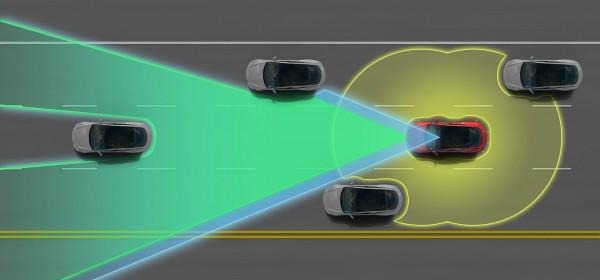How Smart Will Tesla's Model S Autopilot Be?
Tesla's plans for the new Autopilot features on the Model S aren't exactly humble, with CEO Elon Musk suggesting EVs that could come to heel at your beck & call and even read your calendar to know when they might be needed, but what works now and what's merely on the roadmap? Speaking at the launch of the Tesla "D", the AWD version of the Model S, Musk cited regulatory lag for blocking some of the more advanced autonomous features his cars are capable of, so we went hunting to see what, exactly, new owners should expect.
On the hardware front, every new Model S is created equal. Each will come equipped as a matter of course with all the hardware for Autopilot, including twelve long-range ultrasonic sensors and a forward-facing radar, all integrated into the EV's bodywork.
Standard, and enabled by default, will be any of the safety oriented features the system offers. That will include lane-changing warnings – though not the automatic lane-changing which impressed us in the demo – and crash detection, aiming to reduce the impact of a collision.
However, anything Tesla deems "convenience oriented" will require the Tech Package add-on in order to be activated. That, a $4,250 option on the Model S, will include the traffic-aware cruise control and automatic parking system, though your cash also gets you things like navigation, keyless entry, a power tailgate and mirrors, and memory seats.
Not all of the "convenience" features will be active from the start, though. Instead, they'll be installed to the Model S progressively over the span of "a number of months," Tesla tells us.
That will include features like having the car automatically pulling out of the driveway to meet you.

Unsurprisingly, the new features are causing some consternation among existing Tesla owners and those who already had an order in with the company, particularly given Musk's comments that the factory has actually been quietly producing cars fitted with the new sensors for some weeks now.
Spotting the new hardware is fairly straightforward, if you know what you're looking for. The radar system is embedded in the front grille, under the black plastic snout, and is rectangular in shape; meanwhile, new sensors have been added on the fenders, by the wheels.
Finally, the rear-view mirror has been redesigned, with a front-facing camera added. Cars produced from September 19th 2014 seem to be the newest models with the Autopilot hardware, though production of the "D"-spec AWD versions won't begun until February 2015.
According to Tesla, if you have an order in for a RWD Model S and it's not yet begun production, you can pay the upgrade cost for the "D" version – $4,000 more for a 60D or 85D; $14,000 more for the P85D – and switch your order over. That will also delay delivery until next year, of course.
If you want the Autopilot technology, though, that's proving more complex. Tesla has no current plans for a retrofit option, so your existing Model S can't be outfitted with the updated sensor suite.
